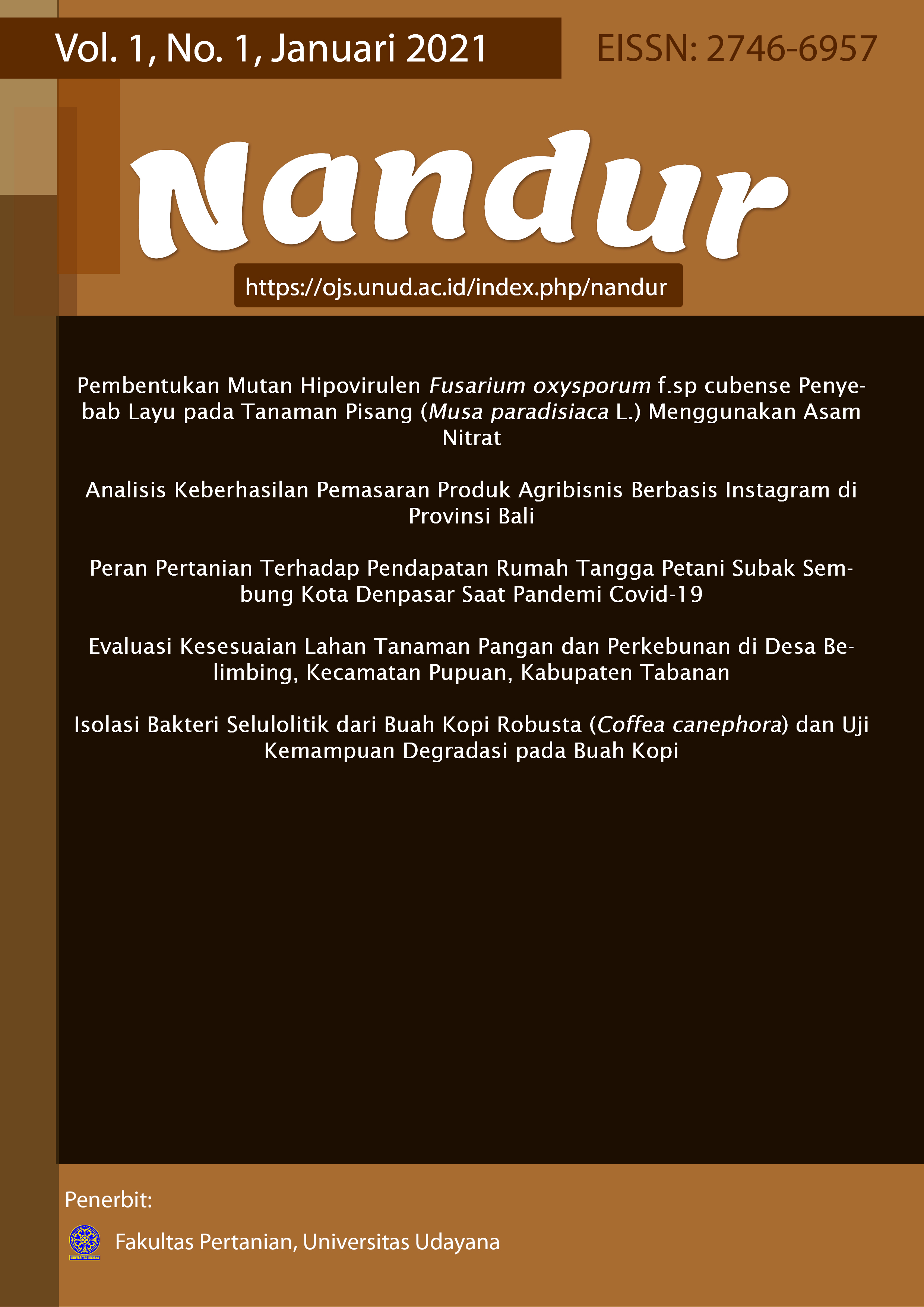Pembentukan Mutan Hipovirulen Fusarium oxysporum f.sp cubense Penyebab Layu pada Tanaman Pisang (Musa paradisiaca L.) Menggunakan Asam Nitrat
Abstract
The Formation of Fusarium oxysporum f.sp. cubense Hypovirulent Mutant Causes Wilt in Banana Plants (Musa Paradisiaca L.) Using Nitric Acid. Fusarium wilt disease is a type of disease that can cause a quantitative decrease in banana plant production. Fusarium wilt disease is classified as a disease that is difficult to control, because it is underground and forms chlamydospores. Control of Fusarium with biological agents has a positive impact on the environment, one way of biological control using antagonistic microorganisms. Biological agents used are biological agents that are hypovirulent. Hypovirulent properties will compete with host pathogens in competition for space, food, and toxin excretion, thereby suppressing fusarium fungi to enter the vascular tissue of banana plants. Chemical mutagens are mutagenic agents that can cause permanent changes in the composition of DNA. Nitric acid can cause DNA cross-linking in the same strands. Nitric acid was reported as a suitable mutagen to increase the production of lactic acid Lactobacillus delbrueckii. Nitric acid can change the acid-base pair of organisms so that mutations occur. obtained a mutant that is hypovirulent which can suppress the growth of fusarium fungus as a pathogen in banana plants. The results showed that the FOC fungus isolates with 1% treatment had hypovirulent properties compared to 0.05%, 0.1% and 0.5% treatments. Hypovirulent properties are derived from the timing of symptoms. In mutant FOC, 1% of symptoms appeared on day 6. The growth of hypovirulent mutants was expected to be higher than that of pathogenic FOCs. Based on the research, it was found that the fungi had the lowest pathogenicity level, as well as high diameter growth, total spore density, and high amount of inhibition.
References
Dewi, W. (2014). Pengujian Isolat Hipovirulen Jamur Fusarium oxysporum pada Resistensi Tanaman Kentang (Solanum tuberosum) Terhadap Penyakit Layu Fusarium. Skripsi. Universitas Bengkulu. Bengkulu.
Hadisutrisno, B., Somowiyarjo, S., dan Sunarminto, B.H. (1999). Pola Agihan dan Intensitas Penyakit Busuk Pangkal Batang Lada di Provinsi Sulawesi Tenggara. Agroteknos, 4(1):58-65.
Ingraham, J. (2000). Introduction to Microbiology. Pacific Grove, Calif.: Brooks/Cole Pub.
John, R.P., Gangadharan, D.,Nampoothiri, K.M. (2008). Genome shuffling of Lactobacillus delbrueckii mutant and Bacillus amyloliquefaciens through protoplasmic fusion for L-lactic acid production from starchy wastes. Bioresource Technology, 99(17), 8008–8015.
Keanekaragaman dan Patogenisitas Fusarium spp. Asal beberapa Kultivar Pisang . Vol 13, No. 6, Hal 216–228. Institut Pertanian Bogor, Bogor. Jurnal
Leslie JF, Summerell BA. (2006). The Fusarium laboratory manual. Blackwell Professional, Ames, Iowa, USA
Nester, E. (2000). Microbiology: A Human Perspective. Boston: McGraw-Hill Higher Education.
Ploetz RC. (1990). Variability in Fusarium oxysporum f. sp. cubense. Can J Bot.68(6):1357–1363. DOI: http://dx.doi.org/10.1139/b90-173.
Ramdana, S. Dan Andriyani. P, (2016). Isolasi Dan Karakterisasi Jamur Patogen pada Tanaman Murbei (Morus sp.) di Persemaian. Balai Penelitian Dan Pengembangan Lingkungan Hidup Dan Kehutanan Sulawesi Selatan. Makassar.
Saragih, SD. (2009). Jenis-jenis Fungi pada Beberapa Tingkat Kematangan Gambut. Skripsi. Fakultas Pertanian. Universitas Sumatra Utara.
Sastrahidayat. (1989). Ilmu Penyakit Tumbuhan. Usaha Nasional. Surabaya.
Semangun H. 2(000). Penyakit - Penyakit Tanaman Perkebunan di Indonesia. Gadjah Mada University Press. Yogyakarta.
Semangun, H (2007). Penyakit-Penyakit Tanaman Hortikultura Indonesia. Gadjah Mada University Press. Yogyakarta.
Soesanto, L., Soedarmono, N. Prihatiningsih, A. Manan, E. Iriani, & J. Pramono. (2002). Kajian Geofitopatologis Penyakit Busuk Rimpang Tanaman Jahe di Wilayah Jawa Tengah. Laporan Kegiatan. Lembaga Penelitian Universitas Jenderal Soedirman, Purwokerto dan BPTP Jateng, Ungaran. 47 hlm.
Suribabu, K., Govardhan, T.L. & Hemalatha K.P.J. (2014). Strain improvement of Brevibacillus borostelensis R1 for optimization of α-amylase production by mutagens. Journal of Microbiology and Biochemical Technology, 6(3), 123- 127. Doi.org/10.4172/1948- 5948.1000132.
Susetyo, P. (2010). Hubungan Keanekaragaman Cendawan Rizosfer Tanaman Pisang (Musa spp.) dan Penyakit Layu Fusarium. Skripsi. Fakultas Pertanian. Institut Pertanian Bogor.
Tjitrosoepomo G. (1991). Taksonomi Tumbuhan (Spermatophyta). Gadjah Mada University Press. Yogyakarta.



